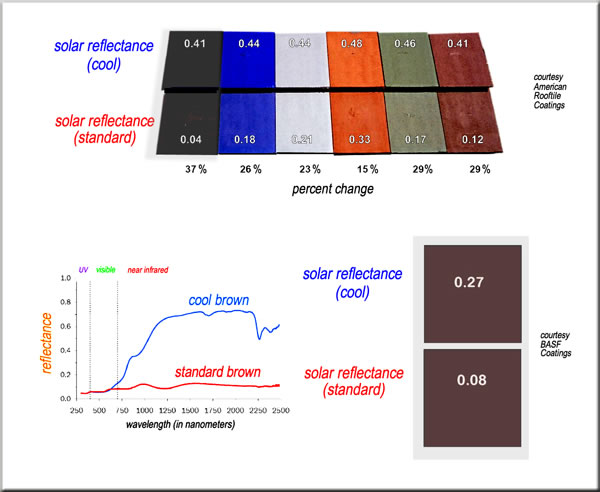

| August 27, 2004 | science beat | | lab a-z index | lab home |
 |
 |
||
|
|||
| Cool Colors, Cool Roofs, part 2 |
| Contact: Allan Chen, a_chen@lbl.gov |
| Cooler pigments Building a cooler color shingle starts with finding cooler pigments. EETD's Hashem Akbari, Paul Berdahl, and Ronnen Levinson have been testing commercially available pigments to measure their solar spectral reflectance — their reflectance versus wavelength over the solar spectrum. For a given color, the ideal pigment is one that reflects as much as possible of the invisible radiation in the near-infrared range. Cool colors are formulated to reflect more sunlight at near-infrared wavelengths. The research team has developed a pigment database with a variety of colors, including browns, blues, purples, greens, and reds, that are highly reflective to near-infrared radiation. When tiles colored with standard pigments were compared with tiles colored with cool pigments, the solar reflectance of the cool pigments was from 15 to almost 40 percent better than color-matched conventional pigments. And with metal roofing panels, while to the eye a cool brown and a standard brown may appear almost the same color, the cool brown is almost 20 percent more solar-reflective than the conventional brown (27 percent versus 8 percent). In addition to testing materials in the lab, Levinson, Berdahl and Akbari have adapted a mathematical model to describe how pigments scatter and transmit light. They will apply the model to develop more reflective cool-colored roofing materials. Using the pigment database and the model, the team is now developing design software for the roofing industry dealing with cool-color coatings. The software estimates the reflectance of the coating using the absorption and scattering properties of the pigment as well as coating composition and geometry. It provides recipes for manufacturing pigmented coatings that maximize the solar reflectance for a given color. Cooler tiles, panels, and shinglesThe next step is to figure out how to apply pigments to relatively simple roofing products such as tiles, metal panels, and wood shake. The team has identified a number of cool pigments appropriate for use in coating metal panels and concrete and clay tiles. Tile roofs are a growing preference in more expensive houses of the western and southern states. 
Roof tiles made with cool-color pigments are far more reflective than standard tiles in the same colors (top), as are metal tiles coated with cool pigments, like the brown tiles at bottom. One manufacturer of metal roofing has already switched most of its product line to these cooler pigments, since the cost was about the same, and it added value for their customers. The team's current efforts focus on asphalt shingles, a more challenging technical problem. Shingles are produced in a multi-step process. Roofing granules (small crushed rocks) are manufactured, and color is applied to them; the granules are then used to coat asphalt-saturated fiberglass sheets. Cool shingles require cool granules. The Berkeley Lab team and its industrial partners have developed a two-layer system for manufacturing cooler roofing granules. In their process, granules are precoated with an inexpensive pigment that is very reflective at near-infrared wavelengths. In the second step, the cool color pigment is applied. The first pigment helps increase the reflectance of granules — it reflects even more light than the cool color pigment would by itself, reducing the amount of near-infrared light absorbed by the granule's dark surface. The industrial partners have now manufactured more than 50 prototype cool shingles, 30 tiles and tile coatings, and 20 metal panel prototypes, including a cool black shingle — 18 percent reflective, well above the 4-percent reflectance of conventional black shingles. Field testing and market acceptanceTo test the field performance and durability of these coatings, Berkeley Lab has teamed with Oak Ridge National Laboratory. The Oak Ridge team has set up a steep-slope assembly test apparatus on its grounds in Oak Ridge, Tennessee, where they are evaluating a variety of samples from the manufacturing partners. Andre Desjarlais, William Miller and their associates have installed representative cool roofing materials at the Oak Ridge roof testing facility. They are measuring the changes in physical and chemical composition of the samples as a result of ultraviolet light, weathering, and temperature changes. The joint Berkeley Lab-Oak Ridge team has also set up weathering panels throughout California to monitor the performance of roofs using test materials from the manufacturing partners. There are seven test sites located throughout the state, in six different climate zones, ranging from mild to severe. Sites are located from the far north of the state, in McArthur, to Meloland at the California-Mexico border. The project team is also collaborating with the Sacramento Municipal Utilities District to measure energy savings and changes in temperature and humidity inside test houses in Sacramento. A number of the new cool coatings are already available on the market through the manufacturing partners. "Since the start of this research," says Akbari, "the solar reflectance of commercially available clay and metal products has increased from the 5 to 25 percent range to the 30 to 45 percent range. Working with our industrial partners, we hope to produce shingles with a solar reflectance of 25 percent or higher, qualifying for an Energy Star cool-roof label." He adds that "some of the products resulting from this research will also qualify as cool roofs in the California building energy code," the 2005 Title 24 California Building Energy Efficiency Standard. Additional information
|
| Top |